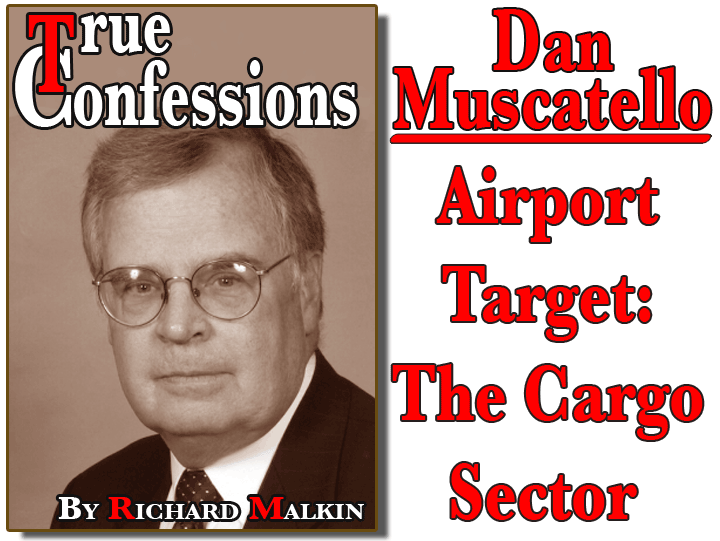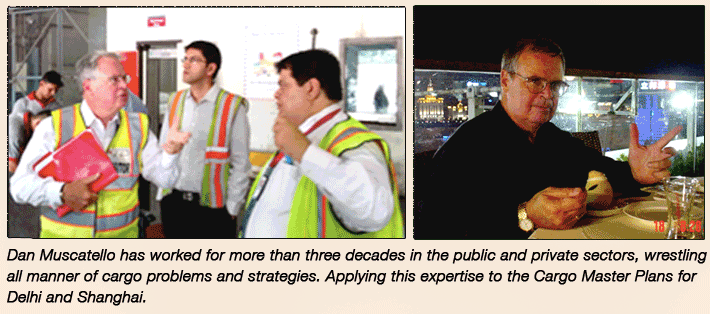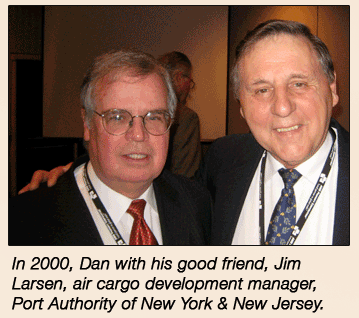| 
Described
in its simplest terms, the design and construction of an airport are for
safe aircraft takeoffs and landings; and in between is Dan Muscatello
who has spent more than three decades in the public and private sectors
wrestling with all manner of cargo problems and strategies. Over the years,
like a planter sowing seeds he has applied his expertise and progressive
outlook around the world. His proven talents as a development strategist
for “both the business and physical facility planning of an air
cargo complex, as well as the integration of an ancillary and logistics
support services,” rank high as an authority.
In my interviews with
top-level air cargo executives, it has been a common practice to seek
respective designations of the world’s three best cargo-handling
airports. When I put the same question to Muscatello, he declined, asserting
that to do so was “virtually impossible.” He explained that
airport operations are vastly different, especially since “comparable
criteria” are not immediately apparent. Also—and this is strikingly
significant—the airlines, not the airport, perform the cargo handling,
and “their levels of emphasis and performance vary dramatically.”
In contrast to the above, Muscatello suggested
three characteristics that a “good cargo operation” will have
and open to airport contribution: (a) physical planning for transfer and/or
O & D activity; (b) a rate structure that produces a fair profit for
cargo operations and building management; (c) along with off-airport businesses,
“strategic integration” of airport cargo operations.
 |
Within the industry,
there is frequent talk about the feasibility of all-cargo airports. What
is the current status of this topic?
In his response, Muscatello pointed out
that despite existence of “well-defined” operating characteristics
that suggest “potential success,” the criteria are met by
extremely few locations for large cargo operations that a freighter airport
required. Muscatello called attention to the fact that more carriers are
becoming more “strategic” in belly-capacity utilization. He
allowed, however, “there will always be exceptions—but not
many.” Could he cite one such exception? His answer: “An airport
created for an integrator/express carrier.” In his opinion, the
opportunities for an all-cargo airport during the next couple of decades
are “pretty limited”.
Asked whether cargo management undergoes
change in accordance with an airport’s location, Muscatello labeled
it a factor, but not as important as the nature of the operation”.
An O & D operation, he said, is influenced by throughput, quite different
from a transfer hub whose requirements are wholly incompatible. Equally
critical is the nature of the cargo. Where international shipments are
concerned, changes can be effected by local customs requirements and police
policies. Muscatello offered two keys—one for cargo management,
one for airports intent on best practices: For cargo management, flexibility,
for airports, ensure that comparisons are “drawn with similar operations”.
 |
For a parenthetical
comment on airline and forwarder complaints, I turn back the centuries
to Horace who observed that something is always lacking to one’s
fortune. The overreaching problem is identical for both: cost. Right behind
this complaint is another: the condition of facilities and infrastructure.
Muscatello further noted:
“Sine 9/11 there has been a lot of
pressure on airports to control costs, and while airports try, they face
the same escalation in pricing as the constituents they serve. Airports
as public entities have to prioritize service and job development in their
business goals, while carriers and forwarders are hit by low yields and
have to manage to the bottom line. In that regard, they pass through increased
costs to their customers. I always found it puzzling that the industry
takes exception when the airports do the same.”
The primacy of airline business is the passenger.
Does this fact present a negative impact on cargo facility needs? Said
Muscatello: In some instances, “absolutely!” But he quickly
cautioned against confusing his answer with an indication of airport neglect.
Not unlike other businesses, he went on to point out, airports must prioritize
“when and how” to allocate money.
Running an airport like a private business
is not an easy job. It calls for the airport manager’s “sensitivity
to the politics and public relations impacts of decisions”.
Turning to the subject of cargo handling,
Muscatello was asked what he believed to be its foremost problem. Speaking
from an airport point of view, he held that too many handling firms and
up to a proliferation of ground service equipment that results in blocking
the apron and creating problems in safety. He added: “I have seen
a number of instances where the value of competition for handling business
is lost by basing everything on price, resulting in poorer service and
higher staff turnover for the handling companies.”
He emphasized his conviction that performance
standards should be developed for handling companies, plus penalties for
unsatisfactory service.
 |
Dan Muscatello, who earned
his Master’s in business administration and executive management
at Pace University, holds the position of director of cargo and logistics
at Landrum & Brown. His broad experience has been translated into
development strategies for business and physical facility planning of
air cargo complexes. As well as the integration of ancillary and supporting
logistics services. His most recent credits include what is described
as “the development of the industry’s most comprehensive strategic
development plan for JFK,” and analysis of California airports’
cargo capacity and facility utilization.
 During
the period 2000-2004 he was employed by John F. Brown Co. as managing
consultant, heading the firm’s air cargo practice. He spent three
years (1997-2000) at DAMG Worldwide in charge of market feasibility determinations.
Prior to this, Muscatello managed air cargo programs for the Port Authority
of New York and New Jersey, described as “the largest air cargo
operation in the world.” He is credited with developing one of the
industry’s “most comprehensive’ air cargo plans. An
item of interest is his management of more than one million square feet
of new air cargo facilities at Kennedy, Newark and LaGuardia Airports.
On a global basis, his prowess in planning produced in excess of 20 million
square feet of cargo facilities. Notably, Muscatello was the first American
contracted by a Chinese airport to lend a hand in cargo marketing. During
the period 2000-2004 he was employed by John F. Brown Co. as managing
consultant, heading the firm’s air cargo practice. He spent three
years (1997-2000) at DAMG Worldwide in charge of market feasibility determinations.
Prior to this, Muscatello managed air cargo programs for the Port Authority
of New York and New Jersey, described as “the largest air cargo
operation in the world.” He is credited with developing one of the
industry’s “most comprehensive’ air cargo plans. An
item of interest is his management of more than one million square feet
of new air cargo facilities at Kennedy, Newark and LaGuardia Airports.
On a global basis, his prowess in planning produced in excess of 20 million
square feet of cargo facilities. Notably, Muscatello was the first American
contracted by a Chinese airport to lend a hand in cargo marketing.
Do radical differences exist among airlines
and forwarders with regard to cargo security? Not much. However, in some
instances effectiveness is undercut by their “physical environment”.
At some airports, despite airline requests, most of the shipments reach
the airport loose, thus contributing an unwelcome burden to the cargo
security operation. Prescreened and cleared cargo “make for a better
operation”.
To what extent do air freight forwarders
and IATA-approved cargo agents come within the scope of Muscatello’s
activities. Quite a bit. Periodically, market assessments are performed
all over the world—“critical to a cargo operation that the
inputs of the forwarders and cargo agents, as well as customs brokers
and government agencies, be factored into the due diligence”. Understanding
forwarder/ agent operating requirements and how they can be “best
integrated” have gained in importance.
Put to the question whether airports in
a general sense, have kept apace of cargo requirements in the Jet Era,
Muscatello replied, “I believe they have.” He went on to say
that probably the greatest change has been “the growth in public-private
partnerships to develop new cargo facilities”. Today, most airports
are placing “increased emphasis on cargo as a job development tool
and a revenue source”. This has resulted in some of them more amenable
to “sharing risk” on development projects.
 |
If the expectations of
major aircraft manufacturers are reasonably accurate, we will enter into
the supersonic era in about a decade from now. Did Muscatello have any
thoughts on this future as it related to cargo? Admitting that he had
not given much thought to the topic, he suggested that in the initial
stage of supersonic air transportation the emphasis will be on passenger
business. Referring to the SST from the standpoint of capacity—the
plane is as large as a regional jet—he said that its hold and operating
cost, “only high passenger rates could make the financials work”.
At least initially, he suspected, the same constraints will hold true
when the supersonic airliner is introduced.
When air cargo management people get together,
especially informally, rarely do they miss comparing the cargo-related
merits of airports. On the same course, Muscatello was asked to identify
the factors that made an airport qualitatively superior to another. Apart
from the “basic drives” of cargo, he set forth the following:
well-versed staff, knowledgeable in cargo operations and the cost of doing
business, and a “willingness” to develop a continuing dialogue
with the cargo community (and listening); impartial and broad-minded acceptance
of “new approaches” to business, including possible shared
risks; and a “realistic perspective” by top airport executives
on business goals that are practical and achievable.
 |
“I think over
the past twenty years there has been a very important shift in how carriers
and airports look at cargo,” Muscatello declared. Under the powerful
thrust of wars, terrorist attacks and economic reversals, the airlines
have managed to oversee revenue and cost more closely. Some airports regard
cargo and its potential revenue in entirely new ways.
Consequently, the following question occurs:
What can be expected to ensue?—“More productive, efficient
and cost-effective levels” by the emerging partnerships.
As the old adage proclaims, improvement
is the law of life, Dan Muscatello took the liberty of applying the law
to cargo-related improvement. The keys to continued growth, he maintained,
point to cost control and operational efficiency. He underscored the fact
that while cargo handling is not within the aiport’s province, cargo
development is dependent on airport business and infrastructure for those
boxes and containers. He was not without opinion on further improvement
at the airport:
“I believe that, space permitting,
airports should consider an integrated on-airport cargo community with
tiered pricing for ground rents. This would include higher rents for facilities
with ramp access and lower rents for forwarder-type facilities that you
might otherwise find off-airport.
Do Muscatello’s responsibilities take
him beyond the airport’s boundaries? The query earned an affirmative
answer and the information that he has been involved with the planning
of off-airport logistics parks, and on- and off-airport facility integration.
The purpose is to assure seamless and secure cargo flows.
On a final note, Muscatello was asked whether
he shared the opinion of certain industry pundits that all-cargo aircraft
will haul more than half of the world air freight by the next decade.
He reacted negatively, pointing out that the current trend is “contrary”
to that. He noted that airlines, especially those with widebodies in their
fleets, are taking advantage of belly capacity “to a far greater
extent than previously”. He anticipates no change for the next several
years. While freighters on certain routes “make sense,” he
considers it risky to make a “blanket assumption”. Regardless
of Boeing and Airbus forecasts, Muscatello recommended a “tight
focus on a balance between capacity and yields—that is, until, and
unless, “a growth in freight can help the bottom line, carriers
will target as much cargo as they can for passenger aircraft”.
Richard
Malkin
 |
malkin101@aircargonews.com |









